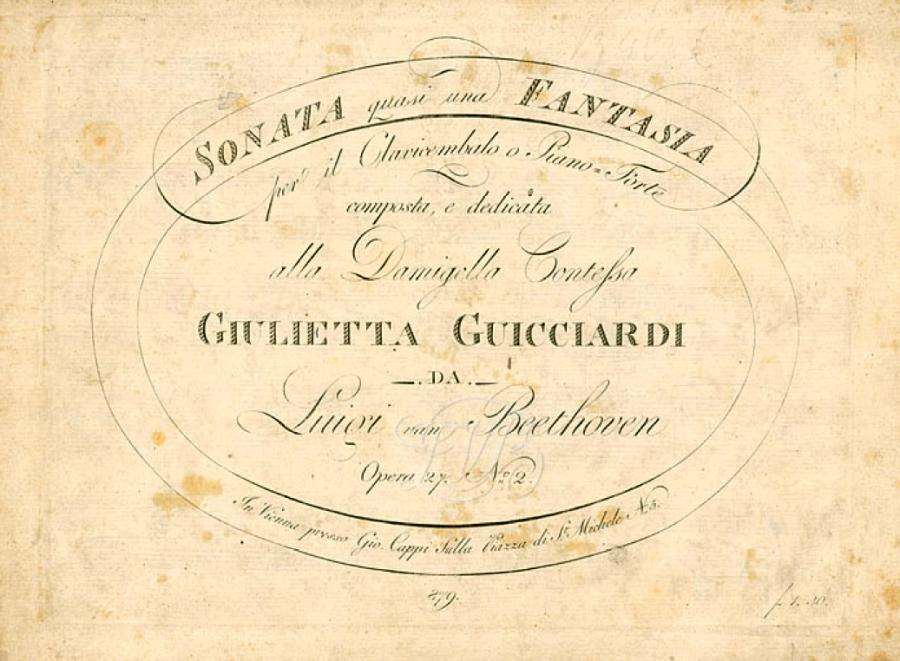The Maestro’s Corner: Beethoven’s “Moonlight Sonata”
November 18, 2014
*Try this link!* Piano Sonata No. 14 in C-sharp minor “Quasi una Fantasia“, Op. 27, No.2
(Throughout this article, there appear sets of numbers in brackets. These signify times (minute:second) in the video attached to this article, so you know what part of the music is being described. If you play the video while reading the article, you can follow along with the musical descriptions.)
The first movement of Ludwig van Beethoven’s Piano Sonata No. 14, Op. 27, No. 2, more commonly known as the “Moonlight Sonata,” is one of the most stunning piano pieces ever written. A well-known melody, there have been numerous adaptations made of it for orchestra, voice, and other instruments. However, none can compare to a solo piano for this melody, especially when the piano is played as ardently as it is by the great pianist Claudio Arrau in the video above.
Beethoven’s reasons for writing the “Moonlight Sonata” confirm why the piece must be played with such despondence—for a gloomy tale lies behind its composition. Once Beethoven got himself a job teaching piano at the court of an Austrian noble, he fell hopelessly in love with the noble’s daughter, the countess Giulietta Guicciardi. Legend states that he proposed to her and she intended to accept, but the romance ended because her father disapproved of the match. Beethoven, then thirty-one, was thirteen years older than Giulietta and had not yet attained as much popularity as he would later on in his life. Still a nomadic composer, performer, conductor, and teacher, Beethoven drifted from job to job, staying only wherever he was paid well, and left to his own devices. Even so, the rejection left Beethoven’s heart broken. He did eventually recover from the affair—although after his death, a small picture of Giulietta was discovered hidden away in his desk. However, it was directly after the unfortunate incident that Beethoven on the verge of a long spell of depression, wrote his fourteenth piano sonata, which he dedicated to the Countess.
The “Moonlight Sonata” expressively chronicles Beethoven’s emotional fluctuations following the broken romance. The first movement (0:10), which signifies his initial despair, resembles a funeral march in the relentless, dirge-like repetition of the ascending triplets and gloomy octaves. The high notes seem to sob in the distance, as if they are dying. At the end, the melody transitions to the left hand, and as the movement gradually slows to its end (5:50), the low, ominous, slightly syncopated notes sound for a fleeting and eerie moment like a heart ceasing to beat. This with the last two deep chords resonating like the ringing of a funeral knell. And, because of this death leitmotif, Claudio Arrau’s interpretation of this piece is the most poignant. Himself an old master, Arrau plays at the height of his career a piece that evokes the nearing end of his own life.
The celebrated first movement of the Sonata often overshadows the rest of the piece, but its other two movements significantly evoke Beethoven’s recovery from his preliminary depression. The second movement (6:54) powerfully contrasts with the first; lively and in a major key. It sounds almost Mozart-esque in its high-spirited, matter-of-fact attitude. In this second stage of his recovery, Beethoven almost seems to be making fun of himself for being foolish enough to fall in love, and so histrionic as to write such a melodramatic first movement. And yet, a faint undertone of sadness weaves throughout the movement as well. With the melancholy of the first movement, Beethoven acknowledges that he made a mistake in risking so much emotion, though he will never forget the Countess. Through the more upbeat air of the second movement, he attempts to bring himself back down to earth. He confesses to himself that despite his disappointment he must continue on composing and performing since music is his life.
The last movement of the Sonata (9:21) is vibrant, intense, and of course taken at breakneck speed. Beethoven’s idiosyncratic short temper and focused energy shows here; he is furious at himself for getting “soft,” furious at the Countess’s father, and generally furious at the world for treating him so callously. Beethoven is in denial, so he attempts to lose himself in his music. He is disguising, or perhaps letting out his anger, in the rapid swoops and deafening bass chords of this last movement. However at the end of the movement, the fury seems to calm down briefly (16:28). Like a short-lived thunderstorm, Beethoven’s temper has abated, and he will soon resume his old ways.
Due to its striking expression, exquisite sentiment, and the relative technical simplicity of its first movement, the “Moonlight Sonata” is the most played and most widely known of Beethoven’s piano sonatas. Beethoven’s emotional turmoil before and during the piece’s composition allowed him to create a piece of otherworldly beauty, and by publishing it he was able to share this little piece of his soul with the entire world. The “Moonlight Sonata” is a little too overpowering to study to, but the next time you experience loss or sadness like a break up with your boyfriend or girlfriend, don’t just lament. Sit down, put on your headphones, close your eyes, and immerse yourself in this magnificent piece of condensed sadness, fury, and love.



